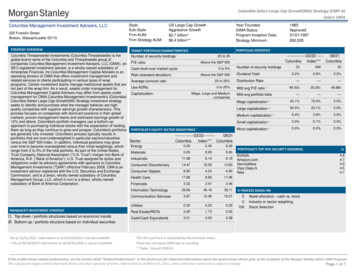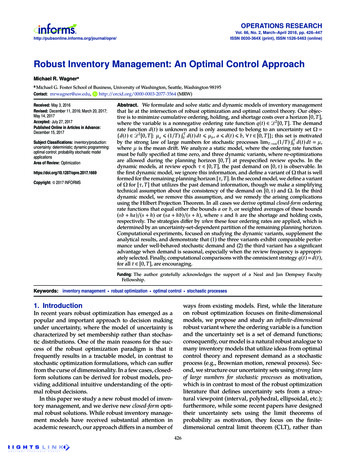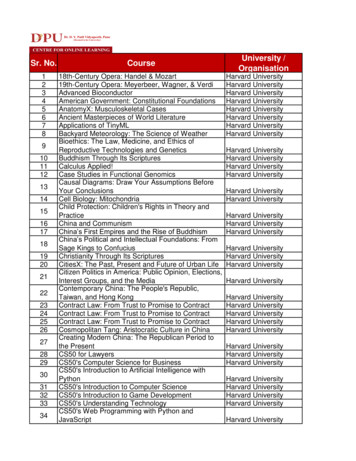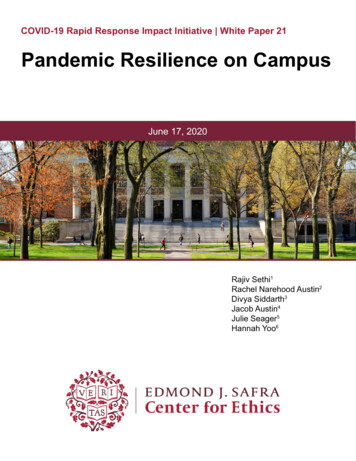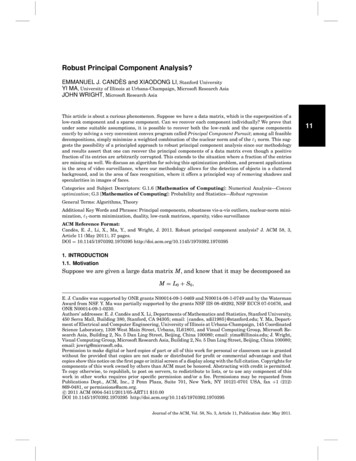
Transcription
Robust Principal Component Analysis?EMMANUEL J. CANDÈS and XIAODONG LI, Stanford UniversityYI MA, University of Illinois at Urbana-Champaign, Microsoft Research AsiaJOHN WRIGHT, Microsoft Research AsiaThis article is about a curious phenomenon. Suppose we have a data matrix, which is the superposition of alow-rank component and a sparse component. Can we recover each component individually? We prove thatunder some suitable assumptions, it is possible to recover both the low-rank and the sparse componentsexactly by solving a very convenient convex program called Principal Component Pursuit; among all feasibledecompositions, simply minimize a weighted combination of the nuclear norm and of the 1 norm. This suggests the possibility of a principled approach to robust principal component analysis since our methodologyand results assert that one can recover the principal components of a data matrix even though a positivefraction of its entries are arbitrarily corrupted. This extends to the situation where a fraction of the entriesare missing as well. We discuss an algorithm for solving this optimization problem, and present applicationsin the area of video surveillance, where our methodology allows for the detection of objects in a clutteredbackground, and in the area of face recognition, where it offers a principled way of removing shadows andspecularities in images of faces.Categories and Subject Descriptors: G.1.6 [Mathematics of Computing]: Numerical Analysis—Convexoptimization; G.3 [Mathematics of Computing]: Probability and Statistics—Robust regressionGeneral Terms: Algorithms, TheoryAdditional Key Words and Phrases: Principal components, robustness vis-a-vis outliers, nuclear-norm minimization, 1 -norm minimization, duality, low-rank matrices, sparsity, video surveillanceACM Reference Format:Candès, E. J., Li, X., Ma, Y., and Wright, J. 2011. Robust principal component analysis? J. ACM 58, 3,Article 11 (May 2011), 37 pages.DOI 10.1145/1970392.1970395 http://doi.acm.org/10.1145/1970392.19703951. INTRODUCTION1.1. MotivationSuppose we are given a large data matrix M, and know that it may be decomposed asM L0 S0 ,E. J. Candès was supported by ONR grants N00014-09-1-0469 and N00014-08-1-0749 and by the WatermanAward from NSF. Y. Ma was partially supported by the grants NSF IIS 08-49292, NSF ECCS 07-01676, andONR N00014-09-1-0230.Authors’ addresses: E. J. Candès and X. Li, Departments of Mathematics and Statistics, Stanford University,450 Serra Mall, Building 380, Stanford, CA 94305; email: {candes, xdil1985}@stanford.edu; Y. Ma, Department of Electrical and Computer Engineering, University of Illinois at Urbana-Champaign, 145 CoordinatedScience Laboratory, 1308 West Main Street, Urbana, IL61801, and Visual Computing Group, Microsoft Research Asia, Building 2, No. 5 Dan Ling Street, Beijing, China 100080; email: yima@illinois.edu; J. Wright,Visual Computing Group, Microsoft Research Asia, Building 2, No. 5 Dan Ling Street, Beijing, China 100080;email: jowrig@microsoft.edu.Permission to make digital or hard copies of part or all of this work for personal or classroom use is grantedwithout fee provided that copies are not made or distributed for profit or commercial advantage and thatcopies show this notice on the first page or initial screen of a display along with the full citation. Copyrights forcomponents of this work owned by others than ACM must be honored. Abstracting with credit is permitted.To copy otherwise, to republish, to post on servers, to redistribute to lists, or to use any component of thiswork in other works requires prior specific permission and/or a fee. Permissions may be requested fromPublications Dept., ACM, Inc., 2 Penn Plaza, Suite 701, New York, NY 10121-0701 USA, fax 1 (212)869-0481, or permissions@acm.org.c 2011 ACM 0004-5411/2011/05-ART11 10.00 DOI 10.1145/1970392.1970395 http://doi.acm.org/10.1145/1970392.1970395Journal of the ACM, Vol. 58, No. 3, Article 11, Publication date: May 2011.11
11:2E. J. Candès et al.where L0 has low rank and S0 is sparse; here, both components are of arbitrary magnitude. We do not know the low-dimensional column and row space of L0 , not even theirdimension. Similarly, we do not know the locations of the nonzero entries of S0 , noteven how many there are. Can we hope to recover the low-rank and sparse componentsboth accurately (perhaps even exactly) and efficiently?A provably correct and scalable solution to the above problem would presumablyhave an impact on today’s data-intensive process of scientific discovery.1 The recentexplosion of massive amounts of high-dimensional data in science, engineering, andsociety presents a challenge as well as an opportunity to many areas such as image,video, multimedia processing, web relevancy data analysis, search, biomedical imagingand bioinformatics. In such application domains, data now routinely lie in thousandsor even billions of dimensions, with a number of samples sometimes of the same orderof magnitude.To alleviate the curse of dimensionality and scale,2 we must leverage on the factthat such data have low intrinsic dimensionality, for example, that they lie on somelow-dimensional subspace [Eckart and Young 1936], are sparse in some basis [Chenet al. 2001], or lie on some low-dimensional manifold [Tenenbaum et al. 2000; Belkinand Niyogi 2003]. Perhaps the simplest and most useful assumption is that the dataall lie near some low-dimensional subspace. More precisely, this says that if we stackall the data points as column vectors of a matrix M, the matrix should (approximately)have low rank: mathematically,M L0 N0 ,where L0 has low-rank and N0 is a small perturbation matrix. Classical PrincipalComponent Analysis (PCA) [Hotelling 1933; Eckart and Young 1936; Jolliffe 1986]seeks the best (in an 2 sense) rank-k estimate of L0 by solvingminimizesubject to M L rank(L) k.(Throughout this article, M denotes the 2-norm; that is, the largest singular valueof M.) This problem can be efficiently solved via the singular value decomposition(SVD) and enjoys a number of optimality properties when the noise N0 is small andindependent and identically distributed Gaussian.Robust PCA. PCA is arguably the most widely used statistical tool for data analysisand dimensionality reduction today. However, its brittleness with respect to grosslycorrupted observations often puts its validity in jeopardy—a single grossly corruptedentry in M could render the estimated L̂ arbitrarily far from the true L0 . Unfortunately,gross errors are now ubiquitous in modern applications such as image processing, webdata analysis, and bioinformatics, where some measurements may be arbitrarily corrupted (due to occlusions, malicious tampering, or sensor failures) or simply irrelevantto the low-dimensional structure we seek to identify. A number of natural approachesto robustifying PCA have been explored and proposed in the literature over severaldecades. The representative approaches include influence function techniques [Huber1981; Torre and Black 2003], multivariate trimming [Gnanadesikan and Kettenring1972], alternating minimization [Ke and Kanade 2005], and random sampling techniques [Fischler and Bolles 1981]. Unfortunately, none of these approaches yields a1 Data-intensive computing is advocated by Jim Gray as the fourth paradigm for scientific discovery [Heyet al. 2009].2 We refer to either the complexity of algorithms that increases drastically as dimension increases, or to theirperformance that decreases sharply when scale goes up.Journal of the ACM, Vol. 58, No. 3, Article 11, Publication date: May 2011.
Robust Principal Component Analysis?11:3polynomial-time algorithm with strong performance guarantees under broad conditions.3 The problem we study here can be considered an idealized version of RobustPCA, in which we aim to recover a low-rank matrix L0 from highly corrupted measurements M L0 S0 . Unlike the small noise term N0 in classical PCA, the entries in S0can have arbitrarily large magnitude, and their support is assumed to be sparse butunknown.4 Motivated by a different set of applications, this problem was also investigated by Chandrasekaran et al. [2009], who also base their work on the formulation(1.1). Their work was carried out independently of ours, while this manuscript was inpreparation. Their results are of a somewhat different nature; see Section 1.5 for adetailed explanation.Applications. There are many important applications in which the data under studycan naturally be modeled as a low-rank plus a sparse contribution. All the statistical applications, in which robust principal components are sought, of course fit ourmodel. We give examples inspired by contemporary challenges in computer science,and note that depending on the applications, either the low-rank component or thesparse component could be the object of interest.—Video Surveillance. Given a sequence of surveillance video frames, we often need toidentify activities that stand out from the background. If we stack the video framesas columns of a matrix M, then the low-rank component L0 naturally corresponds tothe stationary background and the sparse component S0 captures the moving objectsin the foreground. However, each image frame has thousands or tens of thousands ofpixels, and each video fragment contains hundreds or thousands of frames. It wouldbe impossible to decompose M in such a way unless we have a truly scalable solutionto this problem. In Section 4, we will show the results of our algorithm on videodecomposition.—Face Recognition. It is well known that images of a convex, Lambertian surface under varying illuminations span a low-dimensional subspace [Basri and Jacobs 2003].This fact has been a main reason why low-dimensional models are mostly effectivefor imagery data. In particular, images of a human’s face can be well-approximatedby a low-dimensional subspace. Being able to correctly retrieve this subspace is crucial in many applications such as face recognition and alignment. However, realisticface images often suffer from self-shadowing, specularities, or saturations in brightness, which make this a difficult task and subsequently compromise the recognitionperformance. In Section 4, we will show how our method is able to effectively removesuch defects in face images.—Latent Semantic Indexing. Web search engines often need to analyze and indexthe content of an enormous corpus of documents. A popular scheme is the LatentSemantic Indexing (LSI) [Dewester et al. 1990; Papadimitriou et al. 2000]. The basicidea is to gather a document-versus-term matrix M whose entries typically encodethe relevance of a term (or a word) to a document such as the frequency it appearsin the document (e.g. the TF/IDF). PCA (or SVD) has traditionally been used todecompose the matrix as a low-rank part plus a residual, which is not necessarilysparse (as we would like). If we were able to decompose M as a sum of a low-rankcomponent L0 and a sparse component S0 , then L0 could capture common words used3 Randomsampling approaches guarantee near-optimal estimates, but have complexity exponential in therank of the matrix L0 . Trimming algorithms have comparatively lower computational complexity, but guarantee only locally optimal solutions.4 The unknown support of the errors makes the problem more difficult than the matrix completion problemthat has been recently much studied.Journal of the ACM, Vol. 58, No. 3, Article 11, Publication date: May 2011.
11:4E. J. Candès et al.in all the documents while S0 captures the few key words that best distinguish eachdocument from others.—Ranking and Collaborative Filtering. The problem of anticipating user tastes is gaining increasing importance in online commerce and advertisement. Companies nowroutinely collect user rankings for various products, for example, movies, books,games, or web tools, among which the Netflix Prize for movie ranking is the bestknown [Netflix, Inc.]. The problem is to use incomplete rankings provided by theusers on some of the products to predict the preference of any given user on any ofthe products. This problem is typically cast as a low-rank matrix completion problem. However, as the data collection process often lacks control or is sometimes evenad hoc—a small portion of the available rankings could be noisy and even tamperedwith. The problem is more challenging since we need to simultaneously complete thematrix and correct the errors. That is, we need to infer a low-rank matrix L0 from aset of incomplete and corrupted entries. In Section 1.6, we will see how our resultscan be extended to this situation.Similar problems also arise in many other applications such as graphical modellearning, linear system identification, and coherence decomposition in optical systems,as discussed in Chandrasekaran et al. [2009]. All in all, the new applications we havelisted above require solving the low-rank and sparse decomposition problem for matrices of extremely high dimension and under broad conditions, a goal this article aims toachieve.1.2. Our MessageAt first sight, the separation problem seems impossible to solve since the numberof unknowns to infer for L0 and S0 is twice as many as the given measurements inM Rn1 n2 . Furthermore, it seems even more daunting that we expect to reliablyobtain the low-rank matrix L0 with errors in S0 of arbitrarily large magnitude.In this article, we are going to see that not only can this problem be solved, it can besolved by tractable convex optimization. Let M : i σi (M) denote the nuclear normof the matrix M, that is, the sum of the singular values of M, and let M 1 i j Mi j denote the 1 -norm of M seen as a long vector in Rn1 n2 . Then we will show that underrather weak assumptions, the Principal Component Pursuit (PCP) estimate solving5minimizesubject to L λ S 1L S M(1.1)exactly recovers the low-rank L0 and the sparse S0 . Theoretically, this is guaranteedto work even if the rank of L0 grows almost linearly in the dimension of the matrix,and the errors in S0 are up to a constant fraction of all entries. Algorithmically, wewill see that this problem can be solved by efficient and scalable algorithms, at acost not so much higher than the classical PCA. Empirically, our simulations andexperiments suggest this works under surprisingly broad conditions for many typesof real data. The approach (1.1) was first studied by Chandrasekaran et al. [2009]who released their findings during the preparation of this article. Their work wasmotivated by applications in system identification and learning of graphical models. Incontrast, this article is motivated by robust principal component computations in highdimensional settings when there are erroneous and missing entries; missing entriesare not considered in Chandrasekaran et al. [2009]. Hence, the assumptions and resultsof this article will be significantly different from those in Chandrasekaran et al. [2009].5 Although the name naturally suggests an emphasis on the recovery of the low-rank component, we reiteratethat in some applications, the sparse component truly is the object of interest.Journal of the ACM, Vol. 58, No. 3, Article 11, Publication date: May 2011.
Robust Principal Component Analysis?11:5We will comment more thoroughly on the results of Chandrasekaran et al. [2009] inSection 1.5 after introducing ours in Section 1.3.1.3. When Does Separation Make Sense?A normal reaction is that the objectives of this article cannot be met. Indeed, thereseems to not be enough information to perfectly disentangle the low-rank and thesparse components. And indeed, there is some truth to this, since there obviously is anidentifiability issue. For instance, suppose the matrix M is equal to e1 e1 (this matrixhas a one in the top left corner and zeros everywhere else). Then since M is both sparseand low-rank, how can we decide whether it is low-rank or sparse? To make the problemmeaningful, we need to impose that the low-rank component L0 is not sparse. In thisarticle, we will borrow the general notion of incoherence introduced in Candès andRecht [2009] for the matrix completion problem; this is an assumption concerning thesingular vectors of the low-rank component. Write the singular value decomposition ofL0 Rn1 n2 asr L0 U V σi ui vi ,i 1where r is the rank of the matrix, σ1 , . . . , σr are the positive singular values, andU [u1 , . . . , ur ], V [v1 , . . . , vr ] are the matrices of left- and right-singular vectors.Then, the incoherence condition with parameter μ states thatμrμrmax U ei 2 , max V ei 2 ,(1.2)iin1n2and μr .(1.3) U V n1 n2Here, M maxi, j Mi j , that is, is the norm of M seen as a long vector. Note thatsince the orthogonal projection PU onto the column space of U is given by PU U U ,(1.2) is equivalent to maxi PU ei 2 μr/n1 , and similarly for PV . As discussed inCandès and Recht [2009], Candès and Tao [2010], and Gross [2011], the incoherencecondition asserts that for small values of μ, the singular vectors are reasonably spreadout—in other words, not sparse.Another identifiability issue arises if the sparse matrix has low-rank. This will occurif, say, all the nonzero entries of S occur in a column or in a few columns. Suppose forinstance, that the first column of S0 is the opposite of that of L0 , and that all the othercolumns of S0 vanish. Then it is clear that we would not be able to recover L0 and S0by any method whatsoever since M L0 S0 would have a column space equal to, orincluded in that of L0 . To avoid such meaningless situations, we will assume that thesparsity pattern of the sparse component is selected uniformly at random.1.4. Main ResultThe surprise is that, under these minimal assumptions, the simple PCP solution perfectly recovers the low-rank and the sparse components, provided, of course, that therank of the low-rank component is not too large, and that the sparse component isreasonably sparse. Throughout this article, n(1) max(n1 , n2 ) and n(2) min(n1 , n2 ).THEOREM 1.1. Suppose L0 is n n, obeys (1.2)–(1.3). Fix any n n matrix ofsigns. Suppose that the support set of S0 is uniformly distributed among all sets ofcardinality m, and that sgn([S0 ]i j ) i j for all (i, j) . Then, there is a numericalconstant c such that with probability at least 1 cn 10 (over the choice of support of S0 ),Journal of the ACM, Vol. 58, No. 3, Article 11, Publication date: May 2011.
11:6E. J. Candès et al. Principal Component Pursuit (1.1) with λ 1/ n is exact, that is, L̂ L0 and Ŝ S0 ,provided thatrank(L0 ) ρr n μ 1 (log n) 2andm ρs n2 .(1.4)In this equation, ρr and ρs are positive numerical constants. In the general rectangularcase, where L0 is n1 n2 , PCP with λ 1/ n(1) succeeds with probability at least 1 21 cn 10and m ρs n1 n2 .(1) , provided that rank(L0 ) ρr n(2) μ (log n(1) )In other words, matrices L0 whose singular vectors—or principal components—arereasonably spread can be recovered with probability nearly one from arbitrary andcompletely unknown corruption patterns (as long as these are randomly distributed).In fact, this works for large values of the rank, that is, on the order of n/(log n)2 whenμ is not too large. We would like to emphasize that the only “piece of randomness” inour assumptions concerns the locations of the nonzero entries of S0 ; everything elseis deterministic. In particular, all we require about L0 is that its singular vectors arenot spiky. Also, we make no assumption about the magnitudes or signs of the nonzeroentries of S0 . To avoid any ambiguity, our model for S0 is this: take an arbitrary matrixS and set to zero its entries on the random set c ; this gives S0 .A rather remarkable fact is that there is no tuning parameter in our algorithm.Under the assumption of the theorem, minimizing1 L S 1 ,n(1)n(1) max(n1 , n2 ),always returns the correct answer. This is surprising because one might have expectedthat one would have to choose the right scalar λ to balance the two terms in L λ S 1appropriately (perhaps depending on their relative size). This is, however, clearly notthe case. In this sense,thechoiceλ 1/n(1) is universal. Further, it is not a priori very clear why λ 1/ n(1) is a correct choice no matter what L0 and S0 are. It is themathematical analysis which reveals the correctness of this value. In fact, the proof ofthe theorem gives a whole range of correct values, and we have selected a sufficientlysimple value in that range.Another comment is that one can obtainwith larger probabilities of success, βresults that is, of the form 1 O(n β ) (or 1 O n(1) ) for β 0 at the expense of reducing thevalue of ρr .1.5. Connections with Prior Work and InnovationsThe last year or two have seen the rapid development of a scientific literature concerned with the matrix completion problem introduced in Candès and Recht [2009],see also Candès and Tao [2010], Candès and Plan [2010], Keshavan et al. [2010], Grosset al. [2010], and Gross [2011] and the references therein. In a nutshell, the matrixcompletion problem is that of recovering a low-rank matrix from only a small fractionof its entries, and by extension, from a small number of linear functionals. Althoughother methods have been proposed [Keshavan et al. 2010], the method of choice is touse convex optimization [Candès and Tao 2010; Candès and Plan 2010; Gross et al.2010; Gross 2011; Recht et al. 2010]: among all the matrices consistent with the data,simply find that with minimum nuclear norm. These articles all prove the mathematical validity of this approach, and our mathematical analysis borrows ideas from thisliterature, and especially from those pioneered in Candès and Recht [2009]. Our methods also much rely on the powerful ideas and elegant techniques introduced by DavidGross in the context of quantum-state tomography [Gross et al. 2010; Gross 2011]. InJournal of the ACM, Vol. 58, No. 3, Article 11, Publication date: May 2011.
Robust Principal Component Analysis?11:7particular, the clever golfing scheme [Gross 2011] plays a crucial role in our analysis,and we introduce two novel modifications to this scheme.Despite these similarities, our ideas depart from the literature on matrix completionon several fronts. First, our results obviously are of a different nature. Second, wecould think of our separation problem, and the recovery of the low-rank component, asa matrix completion problem. Indeed, instead of having a fraction of observed entriesavailable and the other missing, we have a fraction available, but do not know whichone, while the other is not missing but entirely corrupted altogether. Although, thisis a harder problem, one way to think of our algorithm is that it simultaneously detects the corrupted entries, and perfectly fits the low-rank component to the remainingentries that are deemed reliable. In this sense, our methodology and results go beyond matrix completion. Third, we introduce a novel derandomization argument thatallows us to fix the signs of the nonzero entries of the sparse component. We believethat this technique will have many applications. One such application is in the areaof compressive sensing, where assumptions about the randomness of the signs of asignal are common, and merely made out of convenience rather than necessity; this isimportant because assuming independent signal signs may not make much sense formany practical applications when the involved signals can all be nonnegative (such asimages).We mentioned earlier the related work [Chandrasekaran et al. 2009], which alsoconsiders the problem of decomposing a given data matrix into sparse and low-rankcomponents, and gives sufficient conditions for convex programming to succeed. Theseconditions are phrased in terms of two quantities. The first is the maximum ratiobetween the norm and the operator norm, restricted to the subspace generatedby matrices whose row or column spaces agree with those of L0 . The second is themaximum ratio between the operator norm and the norm, restricted to the subspaceof matrices that vanish off the support of S0 . Chandrasekaran et al. [2009] show thatwhen the product of these two quantities is small, then the recovery is exact for acertain interval of the regularization parameter.One very appealing aspect of this condition is that it is completely deterministic: itdoes not depend on any random model for L0 or S0 . It yields a corollary that can beeasily compared to our result: suppose n1 n2 n for simplicity, and let μ0 be thesmallest quantity satisfying (1.2), then correct recovery occurs whenever max{i : [S0 ]i j 0} μ0r/n 1/12.j The left-hand side is at least as large as ρs μ0 nr, where ρs is the fraction of entriesof S0 that are nonzero. Since μ0 1 always, this statement only guarantees recoveryif ρs O((nr) 1/2 ); that is, even when rank(L0 ) O(1), only vanishing fractions of theentries in S0 can be nonzero.In contrast, our result shows that for incoherent L0 , correct recovery occurs withhigh probability for rank(L0 ) on the order of n/[μ log2 n] and a number of nonzeroentries in S0 on the order of n2 . That is, matrices of large rank can be recovered fromnon-vanishing fractions of sparse errors. This improvement comes at the expense ofintroducing one piece of randomness: a uniform model on the error support.A difference with the results in Chandrasekaran et al. [2009] is that our analysisleads to the conclusion that a single universal value of λ, namely λ 1/ n, works withhigh probability for recovering any low-rank, incoherent matrix. In Chandrasekaranet al. [2009], the parameter λ is data-dependent, and may have to be selected by solvinga number of convex programs. The distinction between our results and Chandrasekaranet al. [2009] is a consequence of differing assumptions about the origin of the datamatrix M. We regard the universality of λ in our analysis as an advantage, since it mayJournal of the ACM, Vol. 58, No. 3, Article 11, Publication date: May 2011.
11:8E. J. Candès et al.provide useful guidance in practical circumstances where the generative model for Mis not completely known.1.6. Implications for Matrix Completion from Grossly Corrupted DataWe have seen that our main result asserts that it is possible to recover a low-rankmatrix even though a significant fraction of its entries are corrupted. In some applications, however, some of the entries may be missing as well, and this section addressesthis situation. Let P be the orthogonal projection onto the linear space of matricessupported on [n1 ] [n2 ], Xi j , (i, j) ,P X 0,(i, j) / .Then, imagine we only have available a few entries of L0 S0 , which we convenientlywrite asY P obs (L0 S0 ) P obs L0 S0 ;that is, we see only those entries (i, j) obs [n1 ] [n2 ]. This models the followingproblem: we wish to recover L0 but only see a few entries about L0 , and among those afraction happens to be corrupted, and we of course do not know which one. As is easilyseen, this is a significant extension of the matrix completion problem, which seeks torecover L0 from undersampled but otherwise perfect data P obs L0 .We propose recovering L0 by solving the following problem:minimizesubject to L λ S 1P obs (L S) Y.(1.5)In words, among all decompositions matching the available data, Principal ComponentPursuitfinds the one that minimizes the weighted combination of the nuclear norm, andof the 1 norm. Our observation is that under some conditions, this simple approachrecovers the low-rank component exactly. In fact, the techniques developed in thisarticle establish this result:THEOREM 1.2. Suppose L0 is n n, obeys the conditions (1.2)–(1.3), and that obsis uniformly distributed among all sets of cardinality m obeying m 0.1n2 . Supposefor simplicity, that each observed entry is corrupted with probability τ independentlyof the others. Then, there is a numerical constant c such that with probability at least 101 cn , Principal Component Pursuit (1.5) with λ 1/ 0.1n is exact, that is, L̂ L0 ,provided thatrank(L0 ) ρr nμ 1 (log n) 2 ,andτ τs .(1.6)In this equation, ρr and τs are positivenumerical constants. For general n1 n2 rectan gular matrices, PCP with λ 1/ 0.1n(1) succeeds from m 0.1n1 n2 corrupted entries 1 2with probability at least 1 cn 10(1) , provided that rank(L0 ) ρr n(2) μ (log n(1) ) .In short, perfect recovery from incomplete and corrupted entries is possible by convexoptimization.On the one hand, this result extends our previous result in the following way. Ifall the entries are available, that is, m n1 n2 , then this is Theorem 1.1. On theother hand, it extends matrix completion results. Indeed, if τ 0, we have a purematrix completion problem from about a fraction of the total number of entries, andour theorem guarantees perfect recovery as long as r obeys (1.6), which, for largevalues of r, matches the strongest results available. We remark that the recovery isexact, however, via a different algorithm. To be sure, in matrix completion one typicallyJournal of the ACM, Vol. 58, No. 3, Article 11, Publication date: May 2011.
Robust Principal Component Analysis?11:9minimizes the nuclear norm L subject to the constraint P obs L P obs L0 . Here, ourprogram would solveminimizesubject to L λ S 1P obs (L S) P obs L0 ,(1.7)and return L̂ L0 , Ŝ 0! In this context, Theorem 1.2 proves that matrix completionis stable vis-a-vis gross errors.Remark. We have stated Theorem 1.2 merely to explain how our ideas can easilybe adapted to deal with low-rank matrix recovery problems from undersampled andpossibly grossly corrupted data. In our statement, we have chosen to see 10% of theentries but, naturally, similar results hold for all other positive fractions provided thatthey are large enough. We
EMMANUEL J. CANDES and XIAODONG LI , Stanford University YI MA, University of Illinois at Urbana-Champaign, Microsoft Research Asia JOHN WRIGHT, Microsoft Research Asia This article is about a curious phenomenon. Suppose we have a data matrix, which is the superposition of a low-rank component and a sparse component.

